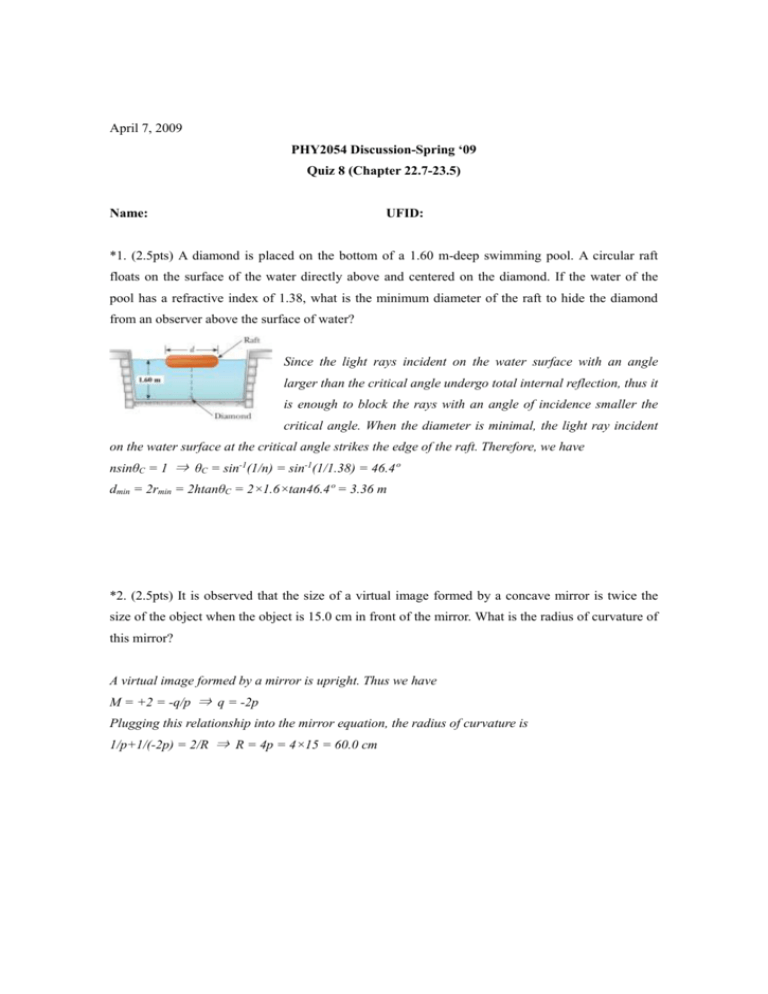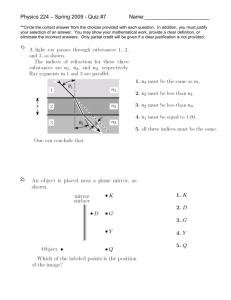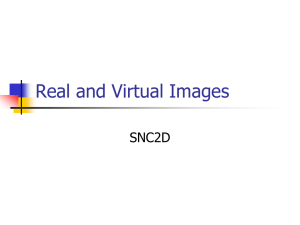Quiz 8
advertisement

April 7, 2009 PHY2054 Discussion-Spring ‘09 Quiz 8 (Chapter 22.7-23.5) Name: UFID: *1. (2.5pts) A diamond is placed on the bottom of a 1.60 m-deep swimming pool. A circular raft floats on the surface of the water directly above and centered on the diamond. If the water of the pool has a refractive index of 1.38, what is the minimum diameter of the raft to hide the diamond from an observer above the surface of water? Since the light rays incident on the water surface with an angle larger than the critical angle undergo total internal reflection, thus it is enough to block the rays with an angle of incidence smaller the critical angle. When the diameter is minimal, the light ray incident on the water surface at the critical angle strikes the edge of the raft. Therefore, we have nsinθC = 1 ⇒ θC = sin-1(1/n) = sin-1(1/1.38) = 46.4º dmin = 2rmin = 2htanθC = 2×1.6×tan46.4º = 3.36 m *2. (2.5pts) It is observed that the size of a virtual image formed by a concave mirror is twice the size of the object when the object is 15.0 cm in front of the mirror. What is the radius of curvature of this mirror? A virtual image formed by a mirror is upright. Thus we have M = +2 = -q/p ⇒ q = -2p Plugging this relationship into the mirror equation, the radius of curvature is 1/p+1/(-2p) = 2/R ⇒ R = 4p = 4×15 = 60.0 cm Constants & Formulas Total Internal Reflection: sinθC = n2 / n1 for n1>n2 Spherical Mirror: 1/p+1/q =2/R, M = -q/p Flat Refracting Surface: q = -(n2 /n1)p, M = 1 Spherical Refracting surface: n1/p+n2/q =(n2 –n1)/R, M = -(n1q)/(n2p) ***3. (2.5pts) A transparent sphere with radius R = 20.0 cm and refractive index n = 1.80 has a mirrored surface on its right half. An object is placed 40.0 cm from the left end of the sphere. Locate the final image of the object. (Assume all the rays are close to the principal axis.) The position of the image due to the left surface of the sphere is 1/p+n/q1 = (n-1)/R ⇒ 1/40+1.8/q = (1.8-1)/20 ⇒ q = 120 cm to the right of the left surface of the sphere. This serves as the object for the mirrored surface. The object distance and the image distance due to the mirror are |p2|= |p1|-2R = 80 cm ⇒ p2 = -80 cm 1/p2+1/q2 = 2/R ⇒ 1/(-80)+1/q2 = 2/20 ⇒ q2 = 8.89 cm After the reflection, the rays refract at the left surface of the sphere again. The object distance is |p3| = |2R-q2| = 31.1 cm ⇒ p3 = +31.1 cm The final position of the object is n/p3+1/q = (1-n)/R ⇒ 1.8/31.1+1/q = (1-1.8)/20 ⇒ q = -10.2 cm 10.2 cm to the right of the left surface of the sphere **4. (2.5pts) A crown glass block (n = 1.520) rests on the bottom of a water tank. The block has a height of 20.0 cm and covered with water (n = 1.333) to a depth of 15.0 cm. What is the apparent height of the block as it is seen from above the water? The apparent height is the distance between the image of the top surface and that of the bottom surface. The image of the top surface is located at (We solve this problem algebraically, for the numerical solution was given in the class.) qT = -(na/nw)d The image of the bottom surface is formed due to two refractions: one at the top of the block and the other at the water surface. The image of the bottom surface is located at qB = -(na/nw)p2 = -(na/nw) (d-q1) = -(na/nw) (d+(nw/ng)h) = -(na/nw) d-(na/ng)h The apparent height is h’ = qT-qB = -(na/nw)d+(na/nw) +(na/ng)h = (na/ng)h = (1/1.52)×20 = 13.2 cm Thus the apparent height does not depend on the intermediate medium.






